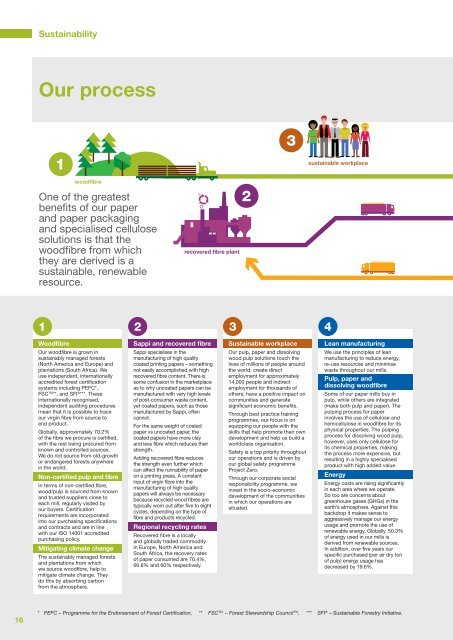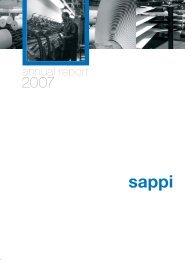2012 Integrated report - Sappi
2012 Integrated report - Sappi
2012 Integrated report - Sappi
You also want an ePaper? Increase the reach of your titles
YUMPU automatically turns print PDFs into web optimized ePapers that Google loves.
Sustainability<br />
Our process<br />
3<br />
1<br />
sustainable workplace<br />
woodfibre<br />
One of the greatest<br />
benefits of our paper<br />
and paper packaging<br />
and specialised cellulose<br />
solutions is that the<br />
woodfibre from which<br />
they are derived is a<br />
sustainable, renewable<br />
resource.<br />
recovered fibre plant<br />
2<br />
1<br />
2<br />
3<br />
4<br />
Woodfibre<br />
Our woodfibre is grown in<br />
sustainably managed forests<br />
(North America and Europe) and<br />
plantations (South Africa). We<br />
use independent, internationally<br />
accredited forest certification<br />
systems including PEFC*,<br />
FSC TM **, and SFI ® ***. These<br />
internationally recognised,<br />
independent auditing procedures<br />
mean that it is possible to trace<br />
our virgin fibre from source to<br />
end product.<br />
Globally, approximately 70.2%<br />
of the fibre we procure is certified,<br />
with the rest being procured from<br />
known and controlled sources.<br />
We do not source from old-growth<br />
or endangered forests anywhere<br />
in the world.<br />
Non-certified pulp and fibre<br />
In terms of non-certified fibre,<br />
wood/pulp is sourced from known<br />
and trusted suppliers close to<br />
each mill, regularly visited by<br />
our buyers. Certification<br />
requirements are incorporated<br />
into our purchasing specifications<br />
and contracts and are in line<br />
with our ISO 14001 accredited<br />
purchasing policy.<br />
Mitigating climate change<br />
The sustainably managed forests<br />
and plantations from which<br />
we source woodfibre, help to<br />
mitigate climate change. They<br />
do this by absorbing carbon<br />
from the atmosphere.<br />
<strong>Sappi</strong> and recovered fibre<br />
<strong>Sappi</strong> specialises in the<br />
manufacturing of high quality<br />
coated printing papers – something<br />
not easily accomplished with high<br />
recovered fibre content. There is<br />
some confusion in the marketplace<br />
as to why uncoated papers can be<br />
manufactured with very high levels<br />
of post-consumer waste content,<br />
yet coated papers, such as those<br />
manufactured by <strong>Sappi</strong>, often<br />
cannot.<br />
For the same weight of coated<br />
paper vs uncoated paper, the<br />
coated papers have more clay<br />
and less fibre which reduces their<br />
strength.<br />
Adding recovered fibre reduces<br />
the strength even further which<br />
can affect the runnability of paper<br />
on a printing press. A constant<br />
input of virgin fibre into the<br />
manufacturing of high quality<br />
papers will always be necessary<br />
because recycled wood fibres are<br />
typically worn out after five to eight<br />
cycles, depending on the type of<br />
fibre and products recycled.<br />
Regional recycling rates<br />
Recovered fibre is a locally<br />
and globally traded commodity.<br />
In Europe, North America and<br />
South Africa, the recovery rates<br />
of paper consumed are 70.4%,<br />
66.8% and 60% respectively.<br />
Sustainable workplace<br />
Our pulp, paper and dissolving<br />
wood pulp solutions touch the<br />
lives of millions of people around<br />
the world; create direct<br />
employment for approximately<br />
14,000 people and indirect<br />
employment for thousands of<br />
others; have a positive impact on<br />
communities and generate<br />
significant economic benefits.<br />
Through best practice training<br />
programmes, our focus is on<br />
equipping our people with the<br />
skills that help promote their own<br />
development and help us build a<br />
worldclass organisation.<br />
Safety is a top priority throughout<br />
our operations and is driven by<br />
our global safety programme<br />
Project Zero.<br />
Through our corporate social<br />
responsibility programme, we<br />
invest in the socio-economic<br />
development of the communities<br />
in which our operations are<br />
situated.<br />
Lean manufacturing<br />
We use the principles of lean<br />
manufacturing to reduce energy,<br />
re-use resources and minimise<br />
waste throughout our mills.<br />
Pulp, paper and<br />
dissolving woodfibre<br />
Some of our paper mills buy in<br />
pulp, while others are integrated<br />
(make both pulp and paper). The<br />
pulping process for paper<br />
involves the use of cellulose and<br />
hemicellulose in woodfibre for its<br />
physical properties. The pulping<br />
process for dissolving wood pulp,<br />
however, uses only cellulose for<br />
its chemical properties, making<br />
the process more expensive, but<br />
resulting in a highly specialised<br />
product with high added value.<br />
Energy<br />
Energy costs are rising significantly<br />
in each area where we operate.<br />
So too are concerns about<br />
greenhouse gases (GHGs) in the<br />
earth’s atmosphere. Against this<br />
backdrop it makes sense to<br />
aggressively manage our energy<br />
usage and promote the use of<br />
renewable energy. Globally, 50.3%<br />
of energy used in our mills is<br />
derived from renewable sources.<br />
In addition, over five years our<br />
specific purchased (per air dry ton<br />
of pulp) energy usage has<br />
decreased by 19.6%.<br />
16<br />
* PEFC – Programme for the Endorsement of Forest Certification, ** FSC TM – Forest Stewardship Council TM , *** SFI ® – Sustainable Forestry Initiative.
















